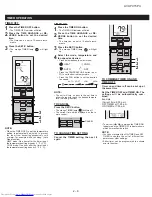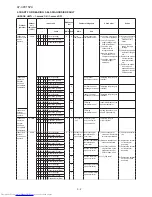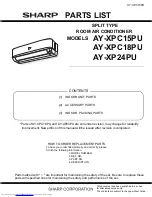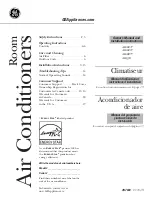
AY-XPC15PU
3 – 8
[2] THERMISTOR TEMPERATURE CHARACTERISTICS.
100
80
60
40
20
0
-10
0
10
20
30
40
ºC
Resistance
Thermistor
Color
Yellow
Orange
Black
Room temperature
thermistor TH1 (CN2 3 - 4 )
Heat exchanger temperature
thermistor TH2 (CN2 1 - 2 )
Valve temperature
thermistor TH3 (CN2 5 - 6 )
Tester
CN2
1
6
Signal
TH1
TH2
TH3
To measure the resistance, first remove
the soldering as shown at right.
Room temperature
thermistor TH1 (Yellow)
25ºC resistance 10
Heat exchanger/Valve thermistor
TH2 (Orange), TH3 (Black)
25ºC resistance 4.431
Temperature
Heat exchanger temperature
Valve temperature
Room temperature
[3] AIR CONDITIONER OPERATION IN THERMISTOR ERROR
*
These models have following thermistors.
The errors for the thermistors that are not mentioned above are irrelevant.
These indoor units don’t have power relay.
INDOOR UNIT
AY-XPC15PU, AY-XPC18PU, AY-XP24PU
Item
Mode
Control operation When resistance
is low (tempera-
ture judged
higher than
actual)
Short-circuit
When resistance
is high (tempera-
ture judged lower
than actual)
Open-circuit
Room temperature
thermistor (TH1)
Auto
Operation mode
judgment
Cooling mode is
activated even if
room temperature
is low.
Cooling mode is acti-
vated in most cases.
Heating mode is
activated even if
room temperature
is high.
Heating mode is
always activated.
Cooling
Frequency control
Room becomes too
cold.
Air conditioner oper-
ates in full power
even when set tem-
perature is reached.
Room does not
become cool.
Compressor does not
operate.
Dehumidifying
Room temperature
memory
Frequency control
Normal operation.
Room temperature is
stored in memory as
31.0
℃
, and com-
pressor does not
stop.
Normal operation.
Room temperature is
stored in memory as
18.5
℃
, and compres-
sor does not operate.
Heating
Frequency control
Room does not
become warm.
Hot keep status
results immediately
after operation starts.
Frequency does not
increase above 30
Hz (40 Hz).
Room becomes too
warm.
Air conditioner oper-
ates in full power even
when set temperature
is reached.
Heat exchanger
thermistor (TH2)
Cooling
Dehumidifying
Freeze prevention
Indoor unit evapo-
ration may freeze.
Indoor unit evapora-
tion may freeze.
Compressor stops
occasionally.
Compressor does not
operate.
Heating
Cold air prevention Cold air prevention
deactivates too
soon and cold air
discharges.
Compressor oper-
ates at low speed or
stop, and frequency
does not increase.
Cold air prevention
deactivates too
slow.
Cold air prevention
does not deactivate,
and indoor unit fan
does not rotate.
TH1, TH2, TH3














































